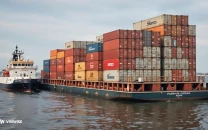Large-scale manufacturing sector registers strong growth

The State Bank of Pakistan (SBP), in its third quarterly (January-March) report released on Tuesday, said the growth in the LSM sector gained further momentum in the third quarter largely in response to rising domestic consumption as well as global recovery.
Specifically, a large part of the LSM growth was driven by a sharp rise in consumer durable industries including automobiles and consumer electronics.
In textiles, pharmaceuticals and chemical sub-sectors, manufacturers benefited from rising export orders too.
“A number of positive developments reinforced growth from January 2010 onwards and dispelled earlier fears of significant moderation to a large extent,” the report said.
The strong demand was further supported by local banks’ renewed interest in consumer finance business from January.
It was earlier feared that activities in textiles might slow down with the end of the cotton season as a large part of textile sector activities in the first half of FY10 was observed in the low value added sectors (ginning and spinning).
However, the pick-up in value added textile exports has eased these concerns. Finally, the demand for electronic appliances remained strong.
Nonetheless, the fear of slowdown in manufacturing growth cannot be disregarded given the prevalent energy bottlenecks, rising commodity prices and a vulnerable law and order situation, the report said.
Likewise, liquidity shortages driven by fiscal constraints in petroleum refining and metal industries are forcing manufacturing firms to operate at low utilisation levels.
Not only has this caused a decline in domestic production but it also has led to increased import pressures in the face of high domestic demand.
From the capacity point of view, however, it appears that the growth momentum can be maintained with better administrative mechanism and utilising available export opportunities, the central bank report said.
Thus, given the demand potential and capacities available in the sector, the debate on sustainability of LSM growth boils down to the issue of energy sufficiency.
Specifically, energy-related imports have reached four per cent of gross domestic product in FY09 and FY10 and any substantial increase in growth will further mount import pressures.
So far in FY10, gas supplies seem more or less sufficient to cater to the LSM requirements.
Nevertheless, from the long-run sustainability perspective, it is crucial to bring construction of dams on top priority to avoid possible water shortages as well as to increase cheaper hydel generation.
Equally important is to expedite infrastructure build-up to tap available coal reserves in the country.
“This will not only ensure energy sufficiency at a low cost for economic activities but will also be helpful in mitigating pressures of increasing growth of energy-driven external imbalances,” the report concluded.
Published in the Express Tribune, June 2nd, 2010.



















COMMENTS
Comments are moderated and generally will be posted if they are on-topic and not abusive.
For more information, please see our Comments FAQ